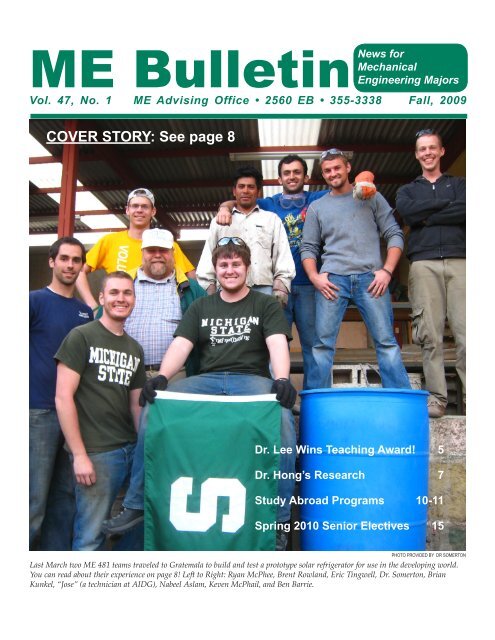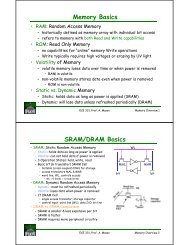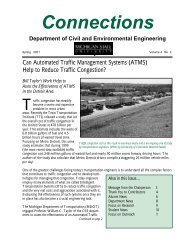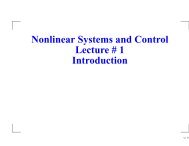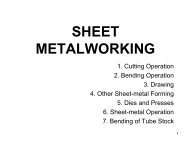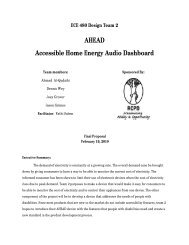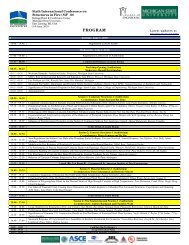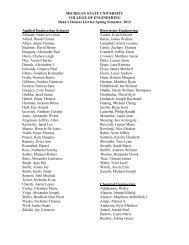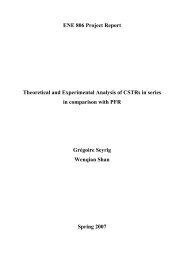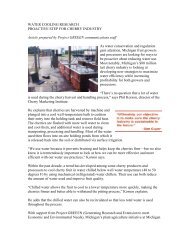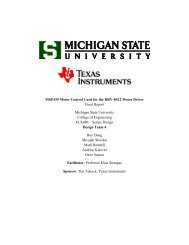ME Bulletin - College of Engineering, Michigan State University
ME Bulletin - College of Engineering, Michigan State University
ME Bulletin - College of Engineering, Michigan State University
Create successful ePaper yourself
Turn your PDF publications into a flip-book with our unique Google optimized e-Paper software.
<strong>ME</strong><br />
for<br />
Mechanical<br />
<strong>Bulletin</strong>News<br />
<strong>Engineering</strong> Majors<br />
Vol. 47, No. 1 <strong>ME</strong> Advising Office • 2560 EB • 355-3338 Fall, 2009<br />
COVER STORY: See page 8<br />
Dr. Lee Wins Teaching Award! 5<br />
Dr. Hong’s Research 7<br />
Study Abroad Programs 10-11<br />
Spring 2010 Senior Electives 15<br />
PHOTO PROVIDED BY DR SO<strong>ME</strong>RTON<br />
Last March two <strong>ME</strong> 481 teams traveled to Gratemala to build and test a prototype solar refrigerator for use in the developing world.<br />
You can read about their experience on page 8! Left to Right: Ryan McPhee, Brent Rowland, Eric Tingwell, Dr. Somerton, Brian<br />
Kunkel, “Jose” (a technician at AIDG), Nabeel Aslam, Keven McPhail, and Ben Barrie.
Department <strong>of</strong> Mechanical <strong>Engineering</strong><br />
Academic Advising<br />
•<strong>ME</strong> Freshmen are advised in W8 Wilson<br />
Hall on a walk-in basis. They do<br />
not need to schedule an appointment.<br />
•<strong>ME</strong> Sophomores (except for Junior-to-<br />
Be’s with a 3.0 or higher) are advised by<br />
Carmellia Davis-King To schedule an<br />
appointment with her, please call 355-<br />
6616 x 1, or go to 1410 EB.<br />
• <strong>ME</strong> Juniors and Seniors plus Juniorsto-Be’s<br />
with a 3.0 or higher GPA are advised<br />
by Gaile Griffore. To schedule<br />
an appointment, please call 355-3338,<br />
or go to 2560 EB.<br />
Tutoring<br />
•The Guided Learning Center (GLC),<br />
located in 1180 EB, <strong>of</strong>fers free drop<br />
in tutoring in math up to differential<br />
equations and science courses (chemistry,<br />
physics, etc.), as well as many<br />
core engineering courses. To request<br />
assistance, go to:<br />
http://www.egr.msu.edu/egr/departments/dpo/academicassistance/glc/<br />
index.html<br />
[Scroll down to Request Assistance,<br />
and click on “request form.”]<br />
•<strong>ME</strong> graduate student and Pi Tau<br />
Sigma undergraduate tutors can be<br />
contacted through the <strong>ME</strong> Advising<br />
Office. These tutors do charge a fee,<br />
which you can negotiate with them. If<br />
you are interested, email Gaile Griffore<br />
at <br />
<strong>ME</strong> <strong>Bulletin</strong><br />
The <strong>ME</strong> <strong>Bulletin</strong> is published twice<br />
a year (fall & spring) for sophomores,<br />
juniors, seniors, faculty, and<br />
staff <strong>of</strong> the Department <strong>of</strong> Mechanical<br />
<strong>Engineering</strong>. Photographs were<br />
taken by Craig Gunn unless noted<br />
otherwise.<br />
Send all correspondence to:<br />
Gaile Griffore, Newsletter Editor<br />
Dept. <strong>of</strong> Mechanical <strong>Engineering</strong><br />
<strong>Michigan</strong> <strong>State</strong> <strong>University</strong><br />
2560 <strong>Engineering</strong> Building<br />
East Lansing, MI 48824-1226<br />
(Telephone: 517-355-3338)<br />
(E-mail: griffore@egr.msu.edu)<br />
2 <strong>ME</strong> <strong>Bulletin</strong> | Fall 2009<br />
Curriculum News<br />
Co-op Students: Before you leave<br />
for your Spring 2010 co-op rotation,<br />
please be sure to discuss your schedule<br />
for next Fall 2010 / Spring 2011<br />
with your academic advisor.<br />
<strong>ME</strong> 481–<strong>ME</strong> Design Projects requires<br />
department approval before you<br />
can enroll, and you must take this<br />
course during your last semester (or<br />
spring for August graduates). To obtain<br />
approval, schedule an appointment<br />
with Gaile to finalize your longterm<br />
schedule. Call 355-3338 or stop<br />
by 2560 EB to make an appointment.<br />
<strong>ME</strong> 489–Technical Communications<br />
(2 credits) is on the spring schedule.<br />
Instructor: Craig Gunn, <strong>ME</strong> Director<br />
<strong>of</strong> Communications. IMPORTANT:<br />
This course is an Other Elective. It is not<br />
a Senior Elective.<br />
�<strong>ME</strong> 491/001–Intro to Computational<br />
Fluid Dynamics (3 credits) will be<br />
<strong>of</strong>fered Spring 2010 as a non-design<br />
intensive Senior Elective. It will taught<br />
along with graduate students who<br />
will take the course as <strong>ME</strong> 840, and<br />
who will have different assignments.<br />
For more information, see page 15.<br />
Class Standing. <strong>ME</strong> juniors and<br />
seniors can obtain this information<br />
in 2560 EB. Sophomores should go to<br />
1410 EB. Be prepared to show your<br />
MSU I.D.<br />
Teaching Award Nomination Form:<br />
Job Search Advice: Jennifer Jennings<br />
from Career Services & Placement<br />
is available to answer questions<br />
about your job search. To schedule an<br />
appointment with her, go to the Center<br />
in 1340 EB, or go to: http://careernetwork.msu.edu/students/advising<br />
Prerequisites: The <strong>ME</strong> department<br />
expects all students, including members<br />
<strong>of</strong> the Honors <strong>College</strong>, to observe all<br />
course prerequisite requirements. If<br />
you have a question about prerequisites,<br />
contact the <strong>ME</strong> Advising Office.<br />
IAH/ISS Diversity<br />
Requirement<br />
Many courses in the Arts and Humanities<br />
area and in the Social, Behavioral,<br />
and Economic Sciences area, emphasize<br />
national diversity (designated<br />
“N” at the end <strong>of</strong> the course title), or<br />
international and multicultural diversity<br />
(designated “I” at the end <strong>of</strong> the<br />
course title). Some emphasize both national<br />
diversity, and international and<br />
multicultural diversity (designated<br />
“D” at the end <strong>of</strong> the course title).<br />
Students must include at least one<br />
“N” course and one “I” course in their<br />
Integrative Studies programs. A “D”<br />
course may meet either an “N” or an “I”<br />
requirement, but not both.<br />
In This Issue<br />
Academic Advising, Curriculum News ................................................................... 2<br />
Department News, Dean’s List .............................................................................. 3<br />
Associate Chair’s Corner by Dr. Somerton, Student Service Award ..................... 4<br />
Dr. Lee Receives Teaching Award ......................................................................... 5<br />
Graduate School by Dr. Feeny, December Graduates .......................................... 6<br />
Preventing Catastrophic Failure <strong>of</strong> Composite Structures by Dr. Lee .................. 7<br />
COVER STORY: An <strong>ME</strong> 481 Project by Dr. Somerton ........................................ 8<br />
Study Abroad: Peru ............................................................................................. 10<br />
Study Abroad: Aachen, Germany & Edinburgh, Scotland ................................... 11<br />
Pi Tau Sigma, Craig Gunn’s Column .................................................................. 12<br />
Social Media and Your Job Search, Summer Job Tips, AS<strong>ME</strong>............................ 13<br />
SAE Baja, SAE Formula ...................................................................................... 14<br />
Spring Semester Senior Electives ...................................................................... 15<br />
Calendar <strong>of</strong> Upcoming Events ............................................................................. 16
https://stuedms.msu.edu/withrow.php (Deadline: Nov 20)<br />
Department News<br />
•Dr. Eann Patterson has been appointed<br />
Director <strong>of</strong> the Composite<br />
Vehicle Researach Center (CVRC). He<br />
has served the <strong>ME</strong> department chairperson<br />
for the last five years.<br />
•Pr<strong>of</strong>essor Alex Díaz has been appointed<br />
as interim Chairperson <strong>of</strong> the<br />
<strong>ME</strong> department.<br />
•Drs. Patrick Kwon and Farhang<br />
Pourboghrat have been promoted to<br />
the rank <strong>of</strong> Full Pr<strong>of</strong>essor.<br />
•Pr<strong>of</strong>essor Norbert Mueller has been<br />
promoted to Associate Pr<strong>of</strong>essor with<br />
tenure.<br />
•Drs. Seungik Baek, Jongeun Choi,<br />
and Tonghun Lee have been promoted<br />
to the rank <strong>of</strong> Associate Pr<strong>of</strong>essor.<br />
•Pr<strong>of</strong>essor Ranjan Mukherjee received<br />
the Fulbright Research Scholarship<br />
in 2009. He spent the spring<br />
semester in the Department <strong>of</strong> Mechano-Informatics,<br />
<strong>University</strong> <strong>of</strong> Tokyo,<br />
Japan, where he worked on mobile<br />
robots for transporting wheelchairbound<br />
persons in long-term-care facilities.<br />
•Dr. David L.S. Hung<br />
has joined the <strong>ME</strong><br />
department as an Associate<br />
Pr<strong>of</strong>essor. He<br />
received his Ph.D. from<br />
Carnegie Mellon <strong>University</strong>.<br />
Before joining MSU, he was<br />
employed in the automotive industry<br />
for over a decade where he was responsible<br />
for developing a gasoline<br />
direct injection system and optical diagnostics<br />
for in-cylinder fuel mixture<br />
preparation and combustion measurements.<br />
His research focuses on spray<br />
atomization, flow sensing diagnostics,<br />
and sustainable energy systems, including<br />
areas such as internal combustion<br />
engines, alternative power<br />
systems, and renewable fuels for<br />
vehicle and aviation applications. Dr.<br />
Hung and his wife, Ling, enjoys outdoor<br />
sports and activities with their<br />
son, Enoch (age 7). He also plays classical<br />
guitar at his leisure and serves in<br />
the music ministry in his church.<br />
•Dr. Tammy Reid-Bush<br />
has been appointed as an<br />
Assistant Pr<strong>of</strong>essor in the<br />
tenure stream. Dr. Reid-<br />
Bush received her Ph.D.<br />
from <strong>Michigan</strong> <strong>State</strong><br />
<strong>University</strong>. Her research<br />
area is biomechanics, including medical,<br />
body adaptations, seating, sports,<br />
and hand function. She has taught<br />
undergraduate courses for a number<br />
<strong>of</strong> years as an Academic Specialist.<br />
Dr. Reid-Bush grew up near Lake<br />
Huron and spent much <strong>of</strong> her time<br />
on the water. She enjoys all types <strong>of</strong><br />
water sports including swimming,<br />
water-skiing, and wind-surfing. She<br />
also enjoy hiking with her family and<br />
photography.<br />
•Pr<strong>of</strong>essor Gaetano<br />
Restivo has joined the<br />
<strong>ME</strong> department as an<br />
Assistant Pr<strong>of</strong>essor. Dr.<br />
Restivo received his<br />
Ph.D. from the <strong>University</strong><br />
<strong>of</strong> Palermo in Italy.<br />
His research focuses on experimental<br />
stress analysis, optical methods,<br />
digital speckle pattern interferometry,<br />
digital photoelasticity, 3-D applications,<br />
mechanics <strong>of</strong> composite materials,<br />
and non-destructive evaluation.<br />
Dr. Restivo has taught <strong>ME</strong> undergrad<br />
courses for several years. He likes to<br />
spend his free time traveling and visiting<br />
new places. He also enjoys swimming<br />
and listening to music (including<br />
Italian opera).<br />
New<br />
Senior<br />
Elective!<br />
<strong>ME</strong> 491/001–Intro to<br />
Computational Fluid Dynamics<br />
See page 15 for<br />
more information<br />
Dean’s List<br />
<strong>Michigan</strong> <strong>State</strong> <strong>University</strong><br />
Congratulations to these 164 <strong>ME</strong> majors<br />
who made the Dean’s List after Spring<br />
and Summer 2009. To be on the Dean’s<br />
List, you must have a semester GPA <strong>of</strong> 3.5<br />
or better. This list is from September 22.<br />
For updates, go to: http://www.reg.msu.<br />
edu/ROInfo/GradHonor/DeansList.asp.<br />
SPRING 2009: Zachary Albright, Paul Allen,<br />
Charles Andrews, Muhammad Aslam, Timothy Aspinall,<br />
Nilutpol Basumatari, Logan Beam, Matthew Berger,<br />
Jenilkumar Bhanvadia, Keren Bian, Amy Bittinger,<br />
Ryan Blake, Stephanie Bonner, Matthew Burdick,<br />
Anthony Carlo, Christopher Cater, Andrew Cawood,<br />
Louis Cervone, John Chancey, Robert Conley, Andrew<br />
Cooper, Alexander Danaj, Joel Darin, Nathaniel Davis,<br />
Mark Davison, Trevor DeLand, Anthony Dellicolli,<br />
Austin Deneff, Thomas Dennis, Alexander Douglass,<br />
Michael Douglass, Christopher Ezop, Christopher Fairbanks,<br />
Neil Ferguson, Michael Fetter, Bradford Fillion,<br />
Alan Finder, Eric Ford, Ian Forney, Lucas Fratta, Allison<br />
Freeman, Katelin Friederichs, Joao Goncalves, Matthew<br />
Gorman, David Goshgarian, James Guitar, Jacob Haf,<br />
Stephen Hammack, Tao Han, Andrew Harbin, Katherine<br />
Hilton, Michael Hines, Jeffrey Holley, Daniel Holmes,<br />
Mark Holmes, Clarence Huff IV, Rachel Jacquin, Nur<br />
Joned, Kyle Justus, Michael Karoub, Ryan Kelly,<br />
David Kempf, Mardan Kerimov, Kameron Kline, Kyle<br />
Kocarek, Jeffrey Laforge, Christopher Lange, Logan<br />
Larson, Jeongseop Lee, Kyungmin Lee, Tae Lee, Matthew<br />
Lempke, Kayton Lenhart, Yirang Liu, Benjamin<br />
Llewellyn, Jung Lu, Ryan Lureau, Jonathan Lusczakoski,<br />
Courtney Macdonald, Arun Mahapatra, Christopher<br />
Massa, Christopher Matthes, Michael Maurer, Rachel<br />
Maurer, Derek Mayoros, Charles McGovern, Nicholas<br />
Mimikos, Eric Mitchell, Michael Mock, Mollie<br />
Montague, Peter Mott, Gregory Moy, Adam Nelligan,<br />
Arthur Newman, Khoa Nguyen, Kurt Northrop, Andrew<br />
Nuttall, Michael O’Brien, Alexandre Oliveira, Fernando<br />
Oliveira, Michael Olsztyn, David Parke, Kunjan Patel,<br />
James Peers, Gregory Pelkie, Timothy Polom, Florian<br />
Pribadi, Matthew Pung, Jiawei Qin, Joshua Racalla,<br />
Michelle Raetz, Adam Rainbolt, Allison Ridder, Joseph<br />
Riggs, Nicholas Righetti, Brian Rockwell, Joseph<br />
Rotellini, Brent Rowland, John Sachs, Adam Sajdak,<br />
Joshua Samp, John Schiefer, Daniel Schleh, Nicholas<br />
Schock, John Schultz, Peter Schultz, Shangyun Shi, Michael<br />
Skierski, Adam Smith, Brian Smith, Ryan Smith,<br />
Scott Smith, Kyle Spiekermann, Jacob Sprague, Jared St<br />
Aubin, Andrew Stuckwisch, Alexander Suradja, Daniel<br />
Svoboda, Ashley Swartz, Joshua Talaga, Eric Tauzer,<br />
Gregory Tenbusch, Daniel Tepe, Thomas Theisen,<br />
Brady Thom, Eric Tingwall, Alexander Tollis, Eric Vine,<br />
Krishna Vistarakula, Eric Waggy, Matthew Weir, Joshua<br />
Whitman, Sara Wiederoder, Nicholas Wilson, Ryan<br />
Wood, Tae You<br />
SUM<strong>ME</strong>R 2000: Nassar Alhajri, Nilutpol Basumatari,<br />
Jeongseop Lee, Kyungmin Lee, Jason Lyman,<br />
Derek Mayoros, Mathieu Rich, Yongjiao Yu<br />
Fall 2009 | <strong>ME</strong> <strong>Bulletin</strong> 3
Department <strong>of</strong> Mechanical <strong>Engineering</strong><br />
Associate Chair Corner<br />
by Pr<strong>of</strong>essor Craig W. Somerton<br />
So how are pr<strong>of</strong>essors<br />
assigned to their<br />
classes? Why does<br />
Pr<strong>of</strong>essor Somerton<br />
always teach <strong>ME</strong> 416?<br />
Why isn’t Dr. Genik<br />
teaching <strong>ME</strong> 410? One<br />
<strong>of</strong> my duties as Associate Chair is to<br />
set the teaching assignments for the<br />
department. Though it sometimes<br />
appears to the students that I pull<br />
names out <strong>of</strong> the hat, let me assure<br />
you that it is a very complicated process.<br />
In fact, it is very much a design<br />
problem in that there are multiple<br />
right answers and the best answer<br />
is very dependent on who’s being<br />
asked the question. What might be a<br />
great set <strong>of</strong> teaching assignments for<br />
Pr<strong>of</strong>essor Diaz, may be the pits for<br />
Dr. Somerton. Let me share with you<br />
what goes into this decision.<br />
There are several goals that are<br />
to be achieved. First, we want the<br />
best teaching possible for our courses.<br />
Second, we want a teaching assignment<br />
to be effective for a faculty<br />
member. That is, we want to provide<br />
him/her with not only the opportunity<br />
to do a great teaching job, but<br />
also the time to be a great researcher.<br />
I begin the process by setting up a<br />
spreadsheet that lists the courses<br />
we are teaching for the academic<br />
year. Next I meet with the department<br />
chair to determine the teaching<br />
load for each faculty member. Not<br />
all faculty teach the same amount.<br />
Outstanding researchers may only<br />
teach one course a year, while faculty<br />
doing little research may teach 4<br />
courses a year. The average teaching<br />
load in our department is 2 courses<br />
a year. Faculty are then surveyed for<br />
their preferences. They are asked to<br />
identify the courses they really want<br />
to teach and those courses they don’t<br />
want anything to do with. With all<br />
this information, I then begin the<br />
4 <strong>ME</strong> <strong>Bulletin</strong> | Fall 2009<br />
assignment process. It is very much<br />
driven by who can teach what.<br />
There are courses that only one or<br />
two faculty can teach, for example,<br />
Dr. Somerton and <strong>ME</strong> 416. There are<br />
faculty that only have one or two<br />
courses in their comfort zone. Other<br />
considerations deal with section<br />
size. Some faculty are great with<br />
classes <strong>of</strong> 20 students, but are much<br />
less effective with classes <strong>of</strong> 60. It is<br />
an iterative process, and I would say<br />
Teaching Award Nomination Form:<br />
<strong>ME</strong> Advisor Receives Withrow Student Service Award<br />
Ms. Gaile Griffore, <strong>ME</strong><br />
Adviser, has received the<br />
2009 Withrow Student<br />
Service Award.<br />
This award is presented<br />
to an adviser,<br />
academic specialist, or<br />
non-tenure-track instructor for outstanding<br />
service to students in the<br />
college. Nominations are submitted<br />
to the dean, and the selection <strong>of</strong> the<br />
winner is made by the <strong>Engineering</strong><br />
Undergraduate Studies Committee.<br />
The award citation reads as follows.<br />
For more than 25 years, Gaile<br />
Griffore has served as academic adviser<br />
to students in mechanical engineering.<br />
She has touched the lives <strong>of</strong><br />
thousands <strong>of</strong> students—likely more<br />
than any other adviser in the college’s<br />
history. Of particular note is her diligence<br />
in guiding students through<br />
the requirements <strong>of</strong> the program and<br />
its unwritten realities (what to take<br />
when, and what not to take concurrently!).<br />
She double-checks everything<br />
and students who follow her guidance<br />
graduate on schedule, without<br />
complications. If she cannot directly<br />
assist a student, she will not give up<br />
until she finds the person or resource<br />
to assist. As noted by a colleague,<br />
“Gaile constantly amazes me with<br />
�����<br />
the lengths to which she goes to make<br />
sure her students have every advantage,<br />
while still staying within the<br />
bounds <strong>of</strong> rules and procedures.” Said<br />
another, “When Gaile is on a quest for<br />
an answer to a pressing advising or<br />
policy question, she is reminiscent <strong>of</strong><br />
Woodward and Bernstein…” One colleague<br />
says, “Within the Undergraduate<br />
Studies Office, we think <strong>of</strong> Ms.<br />
Griffore as ‘bulletpro<strong>of</strong>.’ Her diligence<br />
in advising is second to none; problems<br />
with her degree certifications are<br />
nearly non-existent. Because <strong>of</strong> her<br />
lengthy experience and systems thinking,<br />
she has developed many ‘tips and<br />
tricks’ over the years. In weekly adviser<br />
meetings, her ‘thinking outside the<br />
box’ and willingness to question ‘the<br />
system’ has led to many constructive<br />
discussions leading to improvements<br />
in our work with students.”<br />
Ms. Griffore has a bachelor’s degree<br />
in English from Central <strong>Michigan</strong><br />
<strong>University</strong> and an M.B.A. from <strong>Michigan</strong><br />
<strong>State</strong>. She is a former teacher, and<br />
she served for two years as an academic<br />
adviser for the <strong>College</strong> <strong>of</strong> Veterinary<br />
Medicine. In her spare time,<br />
she enjoys reading and performing on<br />
her flute as a soloist and as a member<br />
<strong>of</strong> several area music ensembles.<br />
one the most challenging optimization<br />
problems I have ever worked<br />
on. I always know one thing. When<br />
I release the assignments to the faculty,<br />
not everyone will be happy and<br />
I’ll hear from them.<br />
So I hope I have provided you<br />
with a glimpse <strong>of</strong> how are teaching<br />
assignments are made. Just remember<br />
that no matter how good or bad<br />
the teaching is, it is still your responsibility<br />
to do the learning.
https://stuedms.msu.edu/withrow.php (Deadline: Nov 20)<br />
Pr<strong>of</strong>essor Lee Receives the 2009 Withrow Award!<br />
Pr<strong>of</strong>essor Tonghun Lee received the 2009<br />
Withrow Teaching Excellence Award<br />
last spring at a special awards luncheon<br />
and ceremony. He was presented with an<br />
inscribed plaque, a medallion to wear at<br />
commencement ceremonies, and a small<br />
stipend. Each year a committee consisting<br />
<strong>of</strong> the last three faculty award winners,<br />
plus student representatives from AS<strong>ME</strong>,<br />
SAE, and Pi Tau Sigma, makes the selection<br />
after reviewing nominations from<br />
<strong>ME</strong> juniors and seniors.<br />
Dr. Lee Joined <strong>ME</strong> department<br />
in 2006 after receiving his Ph.D. from<br />
Stanford <strong>University</strong>. His current research<br />
interests include laser imaging<br />
<strong>of</strong> advanced propulsion, combustion,<br />
and alternative energy conversion<br />
systems.<br />
Dr. Lee cares deeply about the<br />
quality <strong>of</strong> his teaching and invests<br />
substantial effort in providing the<br />
best experience possible for his students.<br />
He creates an environment<br />
where the material becomes understandable<br />
to the students and important<br />
for them to learn—qualities<br />
that are critical in the classroom. This<br />
engenders both respect and admiration<br />
from his students. “He makes<br />
sure that students understand the<br />
theory behind the application,” says<br />
one student. Another student says:<br />
“We had heard all these horror stories<br />
about thermo … but it was not that<br />
bad, thanks to the teacher.” He is described<br />
as “a great and fair teacher!”<br />
and “an excellent teacher who has a<br />
bright mind and a good way <strong>of</strong> transferring<br />
knowledge to his students.”<br />
Simply put by another student, Dr.<br />
Tonghun Lee is a pr<strong>of</strong>essor who “really<br />
is amazing!”<br />
Dr. Lee is teaching <strong>ME</strong> 422-Introduction<br />
to Combustion this semester,<br />
and he is scheduled to teach <strong>ME</strong><br />
201-Thermodynamics during Spring<br />
2010. In his spare time, he enjoys<br />
swimming and playing tennis and<br />
spending time with his 3-year old<br />
son, Taehan.<br />
<strong>Michigan</strong> <strong>State</strong> <strong>University</strong><br />
HARLEY SEELEY<br />
Pr<strong>of</strong>essor Tonghun Lee (left) receives the 2009 Withrow Teaching Excellence Award<br />
from Pr<strong>of</strong>essor Eann Patterson, <strong>ME</strong> Chairperson.<br />
The Withrow Teaching Excellence<br />
Award Nomination Link is<br />
NOW LIVE!<br />
Nominate your favorite pr<strong>of</strong> for the<br />
2010 Withrow Teaching Excellence<br />
Award! It’s easy! Just go to:<br />
https://stuedms.msu.edu/withrow.php<br />
Deadline: Friday, Nov. 20<br />
Fall 2009 | <strong>ME</strong> <strong>Bulletin</strong> 5
Department <strong>of</strong> Mechanical <strong>Engineering</strong><br />
Graduate School in<br />
Mechanical <strong>Engineering</strong><br />
by Pr<strong>of</strong>essor Brian Feeny,<br />
Associate Chair for Graduate<br />
Programs<br />
Did you ever think about going to<br />
graduate school? There are some<br />
good reasons to consider getting an<br />
advanced degree.<br />
•Higher salary. Engineers with<br />
advanced degrees earn more money<br />
than those with BS degrees only.<br />
According to the Bureau <strong>of</strong> Labor<br />
and Statistics Occupational Outlook<br />
Handbook (http://www.bls.gov/<br />
OCO/), the entry pay for an MS in<br />
mechanical engineering is about<br />
$9000 more than that <strong>of</strong> a BS. So an<br />
MS pays for itself in a few years. PhD<br />
entry salaries go up further. Not only<br />
that, but you can . . .<br />
•Get paid to attend grad school.<br />
That’s right--many <strong>of</strong> our grad students<br />
qualify for teaching or research<br />
assistantships. An assistantship covers<br />
a student’s tuition, health care,<br />
and a salary, which together may<br />
have a value <strong>of</strong> about $30,000 per<br />
year. Teaching assistantships for MS<br />
applicants are sometimes somewhat<br />
competitive, so it is worthwhile to<br />
look for research assistantships in<br />
advance. See the “prepare now” section<br />
below.<br />
•Job quality. On the whole, the<br />
engineers with advanced degrees<br />
have more interesting and creative<br />
jobs. An advanced degree puts an<br />
engineer in positions <strong>of</strong> greater leadership,<br />
and therefore enables an engineer<br />
to have more say in his or her<br />
responsibilities. Thus, an advanced<br />
degree is an effective way to propel<br />
an engineer into a flourishing career.<br />
If a research oriented career sounds attractive,<br />
a PhD may be the way to go.<br />
•Grad school is fun. The graduate<br />
school experience is a bit different<br />
from that <strong>of</strong> the BS degree. There<br />
is a little less emphasis on lectures<br />
and exams, although those are still<br />
a strong part <strong>of</strong> the program. But a<br />
6 <strong>ME</strong> <strong>Bulletin</strong> | Fall 2009<br />
56 Seniors to Graduate in December!<br />
graduate student also has a chance<br />
to do some teaching and research.<br />
Most MS students, and all doctoral<br />
students, do a thesis, whereby the<br />
student is involved in a long term<br />
project to investigate a bit <strong>of</strong> the<br />
unknown, and discover how things<br />
work, or how to make things work.<br />
Student researchers are members <strong>of</strong><br />
teams, perhaps in laboratories, building<br />
relationships with their fellow<br />
graduate students and their faculty<br />
advisors. It usually turns out to be a<br />
very meaningful time in a person’s<br />
life, and the research product, especially<br />
a thesis, is something to be<br />
proud <strong>of</strong>.<br />
Prepare now for graduate school.<br />
Graduate school is a scholarly activity,<br />
and to get admitted and to earn an<br />
assistantship, it is important to show<br />
evidence <strong>of</strong> scholarly potential. So<br />
do your best with your coursework,<br />
and get good grades. Get connected.<br />
Teaching Award Nomination Form:<br />
Congratulations to all mechanical engineering December graduates! On behalf<br />
<strong>of</strong> the <strong>ME</strong> faculty, I wish you the greatest happiness and success in your careers,<br />
graduate studies, and personal lives. The following students had applied for<br />
graduation by October 9. If your name is missing, please contact me immediately<br />
(Email Gaile at Tele: 517-355-3338).<br />
Paul McCarthy Allen<br />
Michikazu Aono<br />
Timothy Michael Aspinall<br />
Amber Rae Beebe<br />
Amy Justine Bittinger<br />
Harold Lee Black<br />
Joel Bradley Darin<br />
Joseph Paul Brent<br />
Matthew John Burdick<br />
Elizabeth Anne Carroll<br />
Christopher Reynaldo Cater<br />
Anthony Christian Dellicolli<br />
Kaitlin Michele Donoughe<br />
Allen Warner Eyler<br />
Christopher James Ezop<br />
Timothy Wayne Francisco<br />
James Patrick Guitar<br />
Brittany Ellen Haberstroh<br />
Jacob Ellwood Haf<br />
Stephen Daniel Hammack<br />
Brandon Robert Hengesbach<br />
Michael Anthony Hines<br />
Caitlin Jean Hojnacki<br />
Michael Patrick Karoub<br />
Jeffrey William Laforge<br />
David Richard Lantzy<br />
Benjamin Thomas Llewellyn<br />
Phillip Michael Marino<br />
Bryan Daniel Maxwell<br />
Derek James Mayoros<br />
Eric Richard McElmurry<br />
Christopher Patrick Meyers<br />
Raghav Nanda<br />
Matthew James Owens<br />
Ankita D Patel<br />
Kunjan Vasant Patel<br />
Matthew John Perelli<br />
�����<br />
Kelly Marie Peterson<br />
Eva Marie Reiter<br />
Mathieu Edward Rich<br />
Andrew Scott Rogers<br />
John Robert Sachs<br />
Syed Umer Jalil Saleem<br />
Joshua Michael Samp<br />
Mackenzie Jo Schmidt<br />
Shangyun Shi<br />
Shaheen Shidfar<br />
Ryan Lawrence Smith<br />
John Brian Stukel<br />
Thomas Michael Theisen<br />
Samuel Elliot Tkac<br />
Case Michael Vandenkieboom<br />
Eric Matthew Vine<br />
Krishna Chaitanya Vistarakula<br />
Marissa Ann Wiltz<br />
Ryan Robert Wood<br />
As you develop interest in certain<br />
technical areas, identify faculty who<br />
do research in those areas, and talk to<br />
them. Become a member <strong>of</strong> a research<br />
group. Seek independent studies or<br />
paid undergraduate research projects.<br />
Watch for the summer internship program,<br />
and apply. Also, students can<br />
sometimes find external fellowships<br />
from government institutions like<br />
the National Science Foundation or<br />
NASA. Look around.<br />
Applications for graduate school<br />
can be made at any time. Although<br />
there are stated deadlines, we do take<br />
last-minute applications from our<br />
MSU undergraduates. The sooner you<br />
apply, however, the better your chances<br />
<strong>of</strong> getting an assistantship.<br />
For more information, see the<br />
Graduate Secretary, Aida Montalvo<br />
in the <strong>ME</strong> Graduate Program Office<br />
(2418 EB), or email her at megradad@<br />
egr.msu.edu.
https://stuedms.msu.edu/withrow.php (Deadline: Nov 20)<br />
<strong>Michigan</strong> <strong>State</strong> <strong>University</strong><br />
Preventing Catastrophic Failure <strong>of</strong> Composite Structures by Pr<strong>of</strong>essor Soonsung Hong<br />
Due to recent shift <strong>of</strong> emphasis from test-based confidence<br />
to simulation-based confidence in engineering designs,<br />
the capability to predict performance and reliability <strong>of</strong> advanced<br />
materials has become a crucial component in many<br />
engineering fields. Especially, predicting and thereby preventing<br />
catastrophic failure <strong>of</strong> heterogeneous materials,<br />
such as composite materials, has become one <strong>of</strong> the most<br />
challenging engineering problems.<br />
In heterogeneous materials, complex multiphase microstructure<br />
provides numerous sites and paths for nucleation<br />
and propagation <strong>of</strong> micro-cracks. As a result, macroscopic<br />
crack growth occurs in such a complex way that<br />
its understanding requires knowledge <strong>of</strong> many competing<br />
failure mechanisms operating in multiple length-scales.<br />
In addition, the size <strong>of</strong> the fracture-process zone in the<br />
heterogeneous material is significantly larger than that <strong>of</strong><br />
typical homogeneous engineering materials. Conventional<br />
fracture mechanics models are, therefore, not applicable<br />
to predict fracture processes in heterogeneous materials,<br />
mainly because the condition <strong>of</strong> small-scale yielding can<br />
not be easily satisfied. When large-scale bridging prevails,<br />
the engineering design practices based on single-parameter<br />
fracture criteria are no longer valid such that fracture<br />
toughness values obtained from laboratory tests cannot be<br />
transferred to predict fracture in actual structural components.<br />
Consequently, in large-scale bridging problems, the<br />
prediction <strong>of</strong> fracture must be accomplished by a full-scale<br />
numerical simulation <strong>of</strong> crack growth in actual components<br />
with realistic failure models.<br />
The cohesive zone model is a nonlinear fracture model<br />
that is particularly well-suited for the aforementioned task.<br />
In the model, various complex fracture processes are represented<br />
by unified descriptions <strong>of</strong> traction-separation relations.<br />
The model is proven to be effective when simulating<br />
crack propagation in computational fracture mechanics<br />
studies. There are, however, two major experimental challenges<br />
in accomplishing truly predictive modeling and<br />
simulation <strong>of</strong> crack growth in heterogeneous materials<br />
using the model.<br />
First, there is no established experimental method yet<br />
to determine the traction-separation relations, so called<br />
cohesive zone laws, in a systematic and rigorous way. The<br />
problem is an inverse boundary value problem that seeks<br />
unknown cohesive-zone constitutive laws from far-field<br />
experimental measurements. To make matters worse, the<br />
inverse problem is severely ill-conditioned because extracting<br />
source parameters from rapidly decaying field is extremely<br />
sensitive to the noise in the input data.<br />
On the other hand, the second major obstacle comes<br />
from the fact that there is very little discussion on how to<br />
design and conduct systematic experimental validation<br />
<strong>of</strong> fracture simulation based on the cohesive zone model.<br />
A key element in such experimental validation is to eliminate<br />
“fiddle” parameters in the simulation by providing<br />
well characterized input parameters. Another key element<br />
for the systematic validation is to establish well-designed<br />
benchmark experiments coupled with advanced diagnostic<br />
tools in order to provide well-defined metrics for quantitative<br />
comparison between numerical predictions and experimental<br />
measurements.<br />
Motivated by these critical needs, Dr. Hong is developing<br />
integrated experimental, analytical and numerical<br />
approaches based on full-field optical measurements and<br />
inverse analysis. The primary goal <strong>of</strong> the research is to<br />
establish systematic and rigorous methods to determine<br />
cohesive zone laws from full-field measurements, and to<br />
design and conduct independent benchmark experiments<br />
specifically aimed to validate cohesive-zone modeling <strong>of</strong><br />
crack-growth in heterogeneous materials, such as composite<br />
materials and foam materials.<br />
As an alternative engineering solution to prevent<br />
catastrophic failure in composite structures, Dr. Hong is<br />
also developing self-diagnostic composite materials as a<br />
member <strong>of</strong> the Composite Vehicle Research Center at MSU.<br />
The goal <strong>of</strong> this research is to develop smart composite<br />
structure that can diagnose its own structural health by<br />
monitoring progression <strong>of</strong> damages within itself. This can<br />
be achieved by embedding a network <strong>of</strong> fiber optic sensors,<br />
similar to the human nervous system, in composite structures<br />
where structural integrity must be maintained. The<br />
benefits <strong>of</strong> this approach include real-time update <strong>of</strong> structural<br />
reliability for making informed decision <strong>of</strong> repair or<br />
replacement. Preventing catastrophic failure <strong>of</strong> the composite<br />
structures in air, marine and ground vehicles without<br />
costly tear-down inspection is also key.<br />
GRAPHIC PROVIDED BY DR. HONG<br />
Structural health monitoring <strong>of</strong> composite structures in aircraft<br />
and ground vehicle using the sensor network similar to the<br />
human nervous system.<br />
Fall 2009 | <strong>ME</strong> <strong>Bulletin</strong> 7
Department <strong>of</strong> Mechanical <strong>Engineering</strong><br />
According to the World Health Organization,<br />
nearly half <strong>of</strong> the vaccines<br />
in developing countries go to waste<br />
every year due to temperature spoilage.<br />
Current transportation and storage<br />
methods in remote regions rely<br />
on ice packs that last just a few days.<br />
In order to maintain the optimal temperature<br />
range <strong>of</strong> 2° to 8° C for vaccine<br />
preservation, these regions need<br />
reliable long-term refrigeration where<br />
electricity is not consistently available.<br />
Solving this problem was the<br />
challenge made to two <strong>ME</strong> 481 design<br />
teams during the 2009-2010 academic<br />
year. Each semester one team worked<br />
on the project that resulted in a novel,<br />
solar powered refrigerator that can be<br />
manufactured in a developing country.<br />
To spread the technology, the design<br />
and manufacturing instructions<br />
have been posted on the World Wide<br />
Web as an open source distribution to<br />
allow anyone in the world to utilize<br />
the technology.<br />
This project was brought to the<br />
<strong>ME</strong> Design Program by the Appropriate<br />
Technology Collaborative (ATC).<br />
Founded by John Barrie, ATC is a<br />
non-pr<strong>of</strong>it organization with the goal<br />
“to design, develop, demonstrate and<br />
distribute appropriate technological<br />
solutions for meeting the basic human<br />
needs <strong>of</strong> low income people in the<br />
developing world.” ATC works in collaboration<br />
with clients and other nongovernment<br />
organizations to create<br />
technologies that are culturally sensitive,<br />
environmentally responsible, and<br />
locally repairable in order to improve<br />
the quality <strong>of</strong> life, enhance safety, and<br />
reduce adverse impacts on their environment.<br />
All <strong>of</strong> the designs, which<br />
are created through the ATC, are distributed<br />
freely online to anyone who<br />
wants to use or improve upon them.<br />
The technology employed in this<br />
refrigerator is based on an activated<br />
carbon-ethanol adsorption cycle. The<br />
refrigerator has six main components:<br />
a cold space (where the vaccines are<br />
8 <strong>ME</strong> <strong>Bulletin</strong> | Fall 2009<br />
Teaching Award Nomination Form:<br />
COVER STORY<br />
An <strong>ME</strong> 481 Project: Vaccine Refrigerator for Developing Nations By Craig W. Somerton<br />
kept), an evaporator (which provides<br />
the cooling <strong>of</strong> the cold space), an activated<br />
carbon bed, a solar collector, a<br />
condenser, and a wooden structure (to<br />
hold all <strong>of</strong> the components). A computer<br />
rendering <strong>of</strong> the refrigerator is<br />
shown in Figure 1.<br />
Figure 1 CAD rendering <strong>of</strong> the refrigerator.<br />
An important part <strong>of</strong> this project<br />
was a trip to Guatemala where the<br />
team built and tested a prototype<br />
refrigerator. This was an essential<br />
experience for such a project that results<br />
in a machine intended for use<br />
in the developing world. The design<br />
team must understand the culture <strong>of</strong><br />
the end user, as well as materials and<br />
manufacturing methods available in<br />
the country where the machine will be<br />
used.<br />
With design drawings and manufacturing<br />
directions in hand, the trip<br />
Figure 2 AIDG Workshop<br />
began with a flight from Detroit to<br />
Guatemala City. After arriving in<br />
Guatemala City, the team traveled to<br />
Quetzaltenango (known commonly<br />
as Xela). It had been arranged that the<br />
team would use the workshop <strong>of</strong> the<br />
Appropriate Infrastructure Development<br />
Group (AIDG). The workshop<br />
(Figure 2) was not what the team had<br />
expected. The team had expected<br />
something like the <strong>Engineering</strong> Building<br />
machine shop, but instead found<br />
something more like the Industrial<br />
Project Lab. That is, no machine tools,<br />
just hand tools. A welding system<br />
had to be borrowed from a local trade<br />
school and had to be transported via<br />
taxi, since the AIDG truck was out <strong>of</strong><br />
service.<br />
The first task <strong>of</strong> the team was to<br />
buy the materials required for the<br />
build. These included sheet metal,<br />
copper tubing and fittings, paint, various<br />
screws, bolts and nuts, and an ice<br />
chest to be used for the cold space <strong>of</strong><br />
the refrigerator. The purchasing was<br />
quite an experience as the team went<br />
from shop to shop buying materials<br />
and supplies, with Ben Barrie <strong>of</strong> ATC<br />
translating for the team and Pr<strong>of</strong>essor<br />
Somerton making the payments. To<br />
transport some materials a local driver<br />
would be hired.<br />
With materials in hand, the team<br />
began making their oven. With limited<br />
machine tools available, they had<br />
to modify its manufacturing process.<br />
For example, they had to use a circular<br />
saw to cut the sheet metal (Figure<br />
3). What took an hour in the <strong>Engineering</strong><br />
Building machine shop, took 16<br />
hours at the AIDG workshop! Since<br />
the AIDG workshop was only available<br />
during the day, the team even<br />
resorted to cutting and assembling<br />
copper tubing for the condenser and<br />
evaporator <strong>of</strong> the refrigerator on the<br />
front steps <strong>of</strong> its hostel in the evening<br />
(Figure 4).<br />
At the end <strong>of</strong> four days, the<br />
team had completed the refrigerator,
https://stuedms.msu.edu/withrow.php (Deadline: Nov 20)<br />
Figure 3 Nabeel Aslam uses a circular saw to cut sheet metal.<br />
Figure 4 Ryan McPhee and Eric Tingwall cut copper tubing for the refrigerator’s<br />
condenser and evaporator.<br />
Fall 2008 Team<br />
Bo Hurles<br />
Brian Kunkel<br />
Bryce Thelen<br />
Faculty Advisor<br />
Spring 2009 Team<br />
Nabeel Aslam<br />
Kevin McPhail<br />
Ryan McPhee<br />
Brent Rowland<br />
Eric Tingwall<br />
Pr<strong>of</strong>essional Advisor<br />
Dr. Craig W. Somerton Mr. John Barrie<br />
NOTE: All photos for this article were provided by Dr. Somerton.<br />
<strong>Michigan</strong> <strong>State</strong> <strong>University</strong><br />
charged it with the ethanol, and left it<br />
over night to complete its cooling process<br />
(Figure 5). Early the next morning,<br />
about 6 a.m., two team members<br />
could wait no longer and took the<br />
2-mile walk to the workshop to find<br />
that the refrigerator had cooled the<br />
ice chest down to 1.3°C. The team was<br />
elated with its success.<br />
With its time at the ADIG workshop<br />
completed, the team had the<br />
extraordinary opportunity to visit the<br />
Mayan ruins at Tikal. For those <strong>of</strong> you<br />
who have seen Star Wars, this was<br />
the locale used for the rebel bases in<br />
Episode IV. It was truly spectacular to<br />
see the ruins <strong>of</strong> an enormous city that<br />
existed from 200 to 900 AD. It covers<br />
about 6 square miles, with over 3000<br />
structures, and was estimated to be<br />
the home to 90,000 people. This experience<br />
gave the team unique insight<br />
into Guatemalan culture.<br />
At the end <strong>of</strong> the trip to Guatemala,<br />
the team returned to East<br />
Lansing, where it built a new and<br />
improved prototype based on what<br />
it had learned in Guatemala. Testing<br />
on the new prototype demonstrated<br />
that the technology was feasible and<br />
would be able to maintain vaccines at<br />
the desired temperatures. As a final<br />
acclaim, the Spring 2009 team won<br />
the Edison Award as the best <strong>ME</strong> 481<br />
design project.<br />
Figure 5 The refrigerator as built in<br />
Guatemala.<br />
Fall 2009 | <strong>ME</strong> <strong>Bulletin</strong> 9
Department <strong>of</strong> Mechanical <strong>Engineering</strong><br />
10 <strong>ME</strong> <strong>Bulletin</strong> | Fall 2009<br />
Teaching Award Nomination Form:<br />
Community Engagement and Interdisciplinary Study <strong>of</strong> Global Issues in the<br />
Peruvian Andes by Pr<strong>of</strong>essor Brian Thompson, Program Director<br />
Horace Mann (1796 – 1859), that<br />
great American education reformer,<br />
wrote “Be ashamed to die until you<br />
have won some victory for humanity.”<br />
This compelling string <strong>of</strong> words<br />
resonated with the administration <strong>of</strong><br />
Antioch <strong>College</strong> in Yellow Springs,<br />
Ohio and they adopted the sentence<br />
as the school’s motto.<br />
At Harvard <strong>University</strong>, the Social<br />
Enterprise Club is currently the most<br />
popular student club on campus.<br />
This popularity clearly demonstrates<br />
that a large percentage <strong>of</strong> gifted students<br />
at this elite school possess a<br />
voracious appetite for serving impoverished<br />
people rather than pursuing<br />
the ostentatious lifestyle <strong>of</strong> a Wall<br />
Street baron.<br />
In November 2008, the publication,<br />
Business Week, published an<br />
article on the Millennial Generation at<br />
US business schools. It described how<br />
a significant percentage <strong>of</strong> graduates<br />
were attracted to employment opportunities<br />
that would enhance the lives<br />
<strong>of</strong> the 70 percent <strong>of</strong> the world’s population<br />
that currently live in poverty . .<br />
. micro-financing in Africa, renewable<br />
energy projects, health issues, and op-<br />
erating food banks in Latin America.<br />
As a member <strong>of</strong> the Millennial<br />
Generation, do you possess Mann’s<br />
yearning to have “won some victory<br />
for humanity?” Do you possess the<br />
desire to make a difference, now?<br />
Have you been swept away by this<br />
tsunami <strong>of</strong> social enterprise that’s currently<br />
flooding our nation? Do you<br />
want to help the world’s poor, but you<br />
are uncertain how? Have you ever<br />
contemplated learning about yourself<br />
. . . yes, YOU . . . while transforming<br />
the lives <strong>of</strong> vulnerable under-represented<br />
people?<br />
Why not vigorously insert a brand<br />
new semester-long Peruvian humanitarian<br />
program into your class schedule<br />
next summer? In South America<br />
you will work with very poor indigenous<br />
people that earn about two US<br />
dollars each day. Why not <strong>of</strong>fer these<br />
powerless people the gift <strong>of</strong> dignity<br />
and emancipation through your application<br />
<strong>of</strong> engineering knowledge<br />
to lift them out <strong>of</strong> poverty? Why not<br />
make a pr<strong>of</strong>ound difference, NOW?!<br />
This innovative program <strong>of</strong> community<br />
development in the Andes is<br />
co-sponsored by six MSU colleges and<br />
PHOTO PROVIDED BY DR. THOMPSON<br />
Austin Melcher, a CHE student who is fluent in Spanish, leading a community<br />
workshop on the fabrication <strong>of</strong> solar water heaters and their deployment in practice.<br />
it requires inter-disciplinary teams<br />
<strong>of</strong> students to collaborate with local<br />
NGOs (nongovernmental organizations)<br />
on development projects that<br />
will make a pr<strong>of</strong>ound difference to<br />
communities living in a state <strong>of</strong> poverty<br />
while transforming your own<br />
life too. The co-sponsoring colleges<br />
are Agriculture & Natural Resources,<br />
Arts & Letters, <strong>Engineering</strong>, Social<br />
Science, the James Madison <strong>College</strong><br />
and the Residential <strong>College</strong> <strong>of</strong> Arts &<br />
Humanities.<br />
This semester-long summer program<br />
<strong>of</strong> 13 credits will begin in Cusco,<br />
near Machu Picchu, where students<br />
will attend five weeks <strong>of</strong> ISS classes on<br />
Andean culture and simultaneously<br />
classes in conversational Spanish at<br />
a language institute. Language competency<br />
will be enhanced further by<br />
daily interactions with each student’s<br />
host family and during the execution<br />
<strong>of</strong> the five weeklong community development<br />
project. These faculty-mentored<br />
projects will classify as MSU<br />
directed studies.<br />
During the 2009 program, the<br />
following projects were undertaken<br />
at 10,000 feet in the northern Andean<br />
town <strong>of</strong> Huamachuco where 87 percent<br />
<strong>of</strong> the population live on less<br />
than two dollars a day and 45 percent<br />
live on less than one dollar a day (<strong>of</strong>ficially<br />
classified as extreme poverty):<br />
1) Refinement <strong>of</strong> educational programs<br />
for child workers in silver<br />
mines.<br />
2) Development <strong>of</strong> appropriate social<br />
services for parents.<br />
3) Assessment and promotion <strong>of</strong> tourism.<br />
4) Development and installation <strong>of</strong> a<br />
solar water heater at the town’s hospital.<br />
5) Creation <strong>of</strong> a domestic solar water<br />
heater for poor families. It services<br />
children with special needs at their<br />
school and it also serves as a teaching<br />
aid when this new technology is being<br />
taught to community groups.<br />
–See PERU on next page.
https://stuedms.msu.edu/withrow.php (Deadline: Nov 20)<br />
Aachen Program<br />
An AMAZING opportunity. Imagine<br />
a program that provides an exceptionally<br />
substantive experience (that will<br />
resonate at a job interview or graduate<br />
school admission time) as well as the<br />
opportunity to explore Europe during<br />
three-day weekends. Even better, consider<br />
applying for it.<br />
The substance comes from the<br />
opportunity to carry out 5 MSU<br />
credits <strong>of</strong> <strong>ME</strong> 490 by doing research<br />
in one <strong>of</strong> the institutes <strong>of</strong> the RWTH-<br />
Aachen and studying the German<br />
language, 4 MSU credits, in an environment<br />
where you can readily<br />
hear, read and respond to their native<br />
language on a daily basis. RWTH is<br />
recognized as a world-class technical<br />
university and its reputation is very<br />
well deserved. The two parts <strong>of</strong> the<br />
academic program means that: 1) our<br />
students are given the opportunity to<br />
join a research team and to execute<br />
their own project with subsequent<br />
bragging rights for what they have<br />
accomplished using state-<strong>of</strong>-the-art<br />
equipment, and 2) the language class<br />
makes an important statement about<br />
one’s willingness to adopt a significant<br />
intellectual challenge by engaging a<br />
�����<br />
–PERU, cont’d from page 10<br />
6) Production <strong>of</strong> mini-tubers <strong>of</strong> virusfree<br />
potatoes.<br />
7) Assessment <strong>of</strong> child malnutrition<br />
and the development <strong>of</strong> educational<br />
programs to improve the health <strong>of</strong><br />
children.<br />
If you concur with Horace Mann’s<br />
humanitarian philosophy, then I look<br />
forward to chatting with you about<br />
this life-changing opportunity for you<br />
to discover the real you in the Andes<br />
<strong>of</strong> Peru. Make a difference now! Viva<br />
Peru!<br />
For more information, please<br />
consult http://www.iia.msu.edu/Peru_<br />
study_abroad.html or contact Pr<strong>of</strong>essor<br />
B. Thompson at Thompson@egr.<br />
msu.edu<br />
“The sole meaning <strong>of</strong> life is to serve humanity.”<br />
–L. N Tolstoy (1828 – 1910)<br />
foreign language in the country <strong>of</strong> its<br />
origin.<br />
A preparatory 1-credit <strong>ME</strong> 490 effort<br />
is carried out in the spring before<br />
the summer in Aachen. This provides<br />
a directed running start for the summer<br />
experience. These 6 credits <strong>of</strong> <strong>ME</strong><br />
490 apply to the required 12 credits <strong>of</strong><br />
technical electives that are required<br />
for graduation. The 4 credits <strong>of</strong> German<br />
101 and the 4 credits <strong>of</strong> German<br />
102 (or a higher level German language<br />
course in Aachen for students<br />
with enhanced preparation) apply to<br />
the requirement for “other electives”<br />
that are a part <strong>of</strong> the MSU graduation<br />
requirements.<br />
The following observations were<br />
provided by program participants<br />
Sara Murawa and Ryan Rieck from<br />
the summer <strong>of</strong> 2007. These observations<br />
succinctly identify several <strong>of</strong> the<br />
program’s benefits.<br />
Daily life in the student-oriented<br />
city <strong>of</strong> Aachen is very pleasant. Daily<br />
living costs such as food and entertainment<br />
are comparable to, if not<br />
cheaper than, those in East Lansing.<br />
There’s plenty <strong>of</strong> history. Aachen was<br />
one <strong>of</strong> Charlemagne’s capitols and the<br />
cathedral at the city center dates from<br />
800 A.D. Students’ housing is prearranged<br />
and included in the program<br />
cost. The MSU students are placed<br />
in private rooms in the dorms where<br />
they are integrated with other German<br />
and international students. The<br />
research hosts and German students<br />
are very comfortable in English, as<br />
well as is much <strong>of</strong> Germany’s population.<br />
The people are friendly and<br />
accommodating; Aachen makes a<br />
great environment for international<br />
students.<br />
In all, this program <strong>of</strong>fers independent<br />
research in a nurturing environment<br />
with plenty <strong>of</strong> European<br />
culture exploration opportunities. To<br />
apply for the program, contact Pr<strong>of</strong>essor<br />
John Foss (foss@egr.msu.edu)<br />
Submitted by Pr<strong>of</strong>essor Foss, Program<br />
Director.<br />
<strong>Michigan</strong> <strong>State</strong> <strong>University</strong><br />
Study Abroad at the<br />
<strong>University</strong> <strong>of</strong> Edinburgh<br />
by Gaile Griffore & Craig Somerton<br />
Consider spending a spring semeter<br />
studying abroad at the <strong>University</strong> <strong>of</strong><br />
Edinburgh in Scotland! This recently<br />
established exchange program has already<br />
attracted an Edinburgh student<br />
who is taking MSU courses this year.<br />
Founded in 1582 the <strong>University</strong><br />
<strong>of</strong> Edinburgh is one <strong>of</strong> Europe’s finest<br />
universities with a great tradition<br />
<strong>of</strong> producing outstanding scholars,<br />
including such giants as Charles Darwin<br />
and Sir Arthur Conan Doyle. In<br />
engineering, there is William John<br />
Macquorn Rankine, who proposed<br />
both the Rankine cycle (primary in the<br />
operation <strong>of</strong> steam power plants) and<br />
the Rankine temperature scale (the<br />
absolute scale used in English units).<br />
The mechanical engineering facilities<br />
are very modern, allowing the faculty<br />
and students to pursue research<br />
topics varying from wave energy to<br />
micro-fabrication.<br />
The city <strong>of</strong> Edinburgh, whose<br />
downtown is a short bus ride from<br />
the university’s engineering buildings,<br />
is listed as a World Heritage Site. In<br />
addition, for students seeking leisure<br />
activities the city has a terrific night<br />
life with many activities for young<br />
adults.<br />
You will be able to take courses<br />
that fulfill your entire Senior Elective<br />
requirement (i.e., 12 credits <strong>of</strong> Senior<br />
Electives, including the 3-credit design<br />
intensive course). Possible courses<br />
to be taken while studying at the<br />
<strong>University</strong> <strong>of</strong> Edinburgh include:<br />
• Sustainable Energy Group Design<br />
Project (Design Intensive)<br />
• Marine Energy<br />
• Manufacturing Technology<br />
• <strong>Engineering</strong> for Renewable Energy<br />
• Wind Energy<br />
• Polymers and Composite Materials<br />
For more information about this<br />
exciting new study abroad program,<br />
contact Gaile Griffore, <strong>ME</strong> Advisor,<br />
2560 EB, 517-355-3338 (griffore@egr.<br />
msu.edu)<br />
Fall 2009 | <strong>ME</strong> <strong>Bulletin</strong> 11
Department <strong>of</strong> Mechanical <strong>Engineering</strong><br />
Pi Tau Sigma<br />
Pi Tau Sigma is the National<br />
Mechanical <strong>Engineering</strong><br />
Honor Society<br />
and has chapters in nearly<br />
every <strong>University</strong> <strong>of</strong>fering<br />
a mechanical engineering<br />
program. Pi Tau Sigma<br />
recruits from the top 25%<br />
<strong>of</strong> juniors and 35% <strong>of</strong> seniors<br />
in mechanical engineering and<br />
members are recognized as the elite<br />
students in their class, who <strong>of</strong>ten<br />
excel in industry.<br />
Traditionally, Pi Tau Sigma is involved<br />
in a variety <strong>of</strong> activities that<br />
are academic, social, and in service<br />
to the community. Events through<br />
this honorary society provide an<br />
excellent medium for networking,<br />
not only with other mechanical<br />
engineering students and the community,<br />
but employers as well. For<br />
new members to become acquainted<br />
with each other and to gain familiarity<br />
with the program, “Wing Night”<br />
is a social event held near the beginning<br />
<strong>of</strong> every semester. Service<br />
events include volunteer work at<br />
The Ronald McDonald House, Relay<br />
for Life, Soup Kitchens, and Pet<br />
Adoptions. One <strong>of</strong> Pi Tau Sigma’s<br />
most recognized events is our semiannual<br />
initiation meeting followed<br />
by a complimentary dinner at Olive<br />
Garden. This event is scheduled for<br />
Thursday, November 10th <strong>of</strong> this<br />
semester.<br />
If you are eligible to become a<br />
member <strong>of</strong> Pi Tau Sigma, you will be<br />
notified in the beginning weeks <strong>of</strong><br />
every semester. We believe you have<br />
a lot to gain from this society, so<br />
keep those grades up and we hope<br />
to see you in the spring! Submitted by<br />
Louis Cervone, Secretary.<br />
12 <strong>ME</strong> <strong>Bulletin</strong> | Fall 2009<br />
It’s Resume Time!<br />
by Craig Gunn, <strong>ME</strong> Director <strong>of</strong><br />
Communications<br />
It is that time <strong>of</strong> the semester when<br />
one starts to go into high gear concerning<br />
the preparation for employment,<br />
whether it be a co-op, a summer<br />
stint, or the ultimate full-time adventure.<br />
The new clothes are purchased.<br />
The hair is cut to resemble the industrial<br />
style. People start practicing the<br />
right moves in front <strong>of</strong> the bathroom<br />
mirror.<br />
And low and behold, resumes<br />
are dragged out <strong>of</strong> whatever dingy<br />
place they have been residing, and a<br />
frantic search is made for anyone who<br />
can <strong>of</strong>fer a few guiding principles on<br />
text production, a production that<br />
will lead to an interview, an interview<br />
that will cement the chances for that<br />
desired job. As blood pressure increases<br />
and the need to do the best job<br />
possible on those written documents<br />
looms, it is important to spend some<br />
valuable time on creating documents<br />
that will WOW the reader and put the<br />
writer far ahead <strong>of</strong> the competition.<br />
The information that follows<br />
is not new and the comments are<br />
not hallowed words from on high.<br />
But sometimes we forget the simple<br />
things. We fail to realize that these<br />
simple things may be very critical in<br />
our lives. So what are the things that<br />
you need to have as completely under<br />
your control as possible in that spectacular<br />
resume?<br />
If you haven’t touched your resume<br />
in a year or so, then it needs to<br />
be reviewed, first by you and then<br />
later by others. Pick up the hard copy<br />
or gaze at the screen and look at how<br />
the information flows down the page.<br />
Does a reader immediately know who<br />
wrote the resume, what the writer<br />
wants, his/her degree progress, and<br />
the jobs he/she has held? If the reader<br />
is confused maybe they won’t give it a<br />
second glance.<br />
The next step involves the words<br />
you have used. Have you been careful<br />
to pick just the right words to describe<br />
the jobs you have done? Did you say,<br />
Teaching Award Nomination Form:<br />
“worked 9-5” or “Developed the algorithms<br />
needed to boost rocket efficiency<br />
350% in the Alburdine 2355.”<br />
Probably the second wording creates<br />
a better picture <strong>of</strong> you. As you create<br />
the wording for the resume, have you<br />
given the reader enough detail to really<br />
want to talk to you about employment?<br />
Remember the resume opens the<br />
door. If it only moves the door a crack,<br />
you may never get a positive reply<br />
to your inquiry. Remember to make<br />
yourself human by including activities<br />
that you enjoy doing, but be careful.<br />
Bicycling and painting might be<br />
relatively safe and comfortable to talk<br />
about in an interview, but belonging<br />
to a group that bungee jumps with<br />
cords made <strong>of</strong> crepe paper may not<br />
impress an employer who needs to<br />
know that you will be alive on Monday<br />
to do the jobs assigned. You don’t<br />
need to lie about things, but be wise in<br />
your selection <strong>of</strong> activities.<br />
After you have done your best to<br />
form a clear picture <strong>of</strong> what you have<br />
done in your life, pass those resumes<br />
on. Find as many people as you can<br />
who will pretend to be employers<br />
making judgments on you simply<br />
from the words provided. Make sure<br />
that the group you select is willing to<br />
provide constructive comments that<br />
will make the resume better. A simple,<br />
“I like it or I don’t like it.” doesn’t<br />
<strong>of</strong>fer much to the writer. If they can<br />
explain why, then they can continue<br />
as a reader.<br />
In closing, remember to think <strong>of</strong><br />
your resume as a living document<br />
that needs your continuous attention.<br />
Keep looking at elements that may be<br />
added to the resume or modified to<br />
make it more explicit <strong>of</strong> your qualities.<br />
Then make every effort to gather a<br />
group <strong>of</strong> readers who will give needed<br />
comments on how well you have<br />
accomplished the task <strong>of</strong> telling about<br />
yourself. Evaluate their comments<br />
and use those comments wisely. With<br />
those efforts you will always have<br />
an up-to-date, exciting, and valuable<br />
document to make the best case for<br />
your interview and future job.
https://stuedms.msu.edu/withrow.php (Deadline: Nov 20)<br />
Are Social Media for You<br />
and Your Job Search?<br />
Social<br />
media<br />
can help<br />
you<br />
define<br />
interests, remain current/updated on<br />
news and trends while staying on<br />
track with your job search. So, make<br />
sure you try, join, use, and participate<br />
your way to a great network and successful<br />
job search!<br />
Check out these social media sites:<br />
Linked-In (www.Linkedin.com)<br />
allows you to use on-line networking<br />
to connect and expand your reach to<br />
friends, contacts, employers, jobs and<br />
more. And, over 60,000 MSU alumni<br />
are on LinkedIn. But, it is more<br />
than just signing up . . . you need to<br />
be involved in your network. Join<br />
and contribute to groups (like MSU<br />
Alumni and MSU <strong>Engineering</strong>) and<br />
connect with fellow pr<strong>of</strong>essionals.<br />
Knowing people and networking with<br />
those whom they know can lead to<br />
jobs. For more information on using<br />
LinkedIn try: http://jobsearch.about.<br />
com/b/2009/04/21/linkedin-seek-week.<br />
htm<br />
For a video explanation <strong>of</strong> the<br />
LinkedIn services visit your Spartan<br />
Engineer YouTube site: http://www.<br />
youtube.com/spartancareer.<br />
Try Twitter (http://www.twitter.<br />
com). This is the “Hottest” Job Search<br />
Tool. You can create an account in two<br />
minutes and follow lots <strong>of</strong> career information<br />
sources. To get you started,<br />
follow us at: MSU_egr_job or MSU_<br />
egr_intern. We streamline a number<br />
<strong>of</strong> great opportunities and tips for you<br />
to connect with. Twitter is evolving as<br />
another resource for both job searching<br />
and recruiting check out: http://<br />
www.twitterjobsearch.com<br />
You should then follow with a<br />
number <strong>of</strong> other sources including:<br />
@EngineerJobsUSA (Hottest and Best<br />
Jobs for Engineers across the USA)<br />
@JobsDetroit (Keeping you up to date<br />
with available jobs in Detroit)<br />
@ChicagoEngJobs (<strong>Engineering</strong> jobs in<br />
the greater Chicago area)<br />
@cashforcareers (MSU Career Advice,<br />
Events, and Connections)<br />
Blog about it! Follow what others<br />
with your skills and interests are up to<br />
and learn from them! You have a few<br />
SpartanEngineers that are currently<br />
sharing their stories:<br />
A Spartan in Spain: http://bowenkev.wordpress.com<br />
Eva McSpartan’s Job Search:<br />
http://www.spartanjobseeker.blogspot.com/<br />
Keep in mind that social media<br />
provide one resource (but a powerful<br />
one) and should be used in combination<br />
<strong>of</strong> all available resources to maximize<br />
your networking and job search.<br />
All <strong>of</strong> these resources are at your<br />
finger tips, and we are here too! Don’t<br />
hesitate to contact us. Submitted by Jennifer<br />
Jennings, Field Career Consultant,<br />
The Center, 1340 EB, 517-355-5163, careers@egr.msu.edu<br />
Summer Job Tips<br />
Construct a resume. Send it, along<br />
with a cover letter to companies in<br />
your home town or other preferred<br />
locations. Do not overlook small and<br />
medium sized companies. Be politely<br />
persistent and follow up with another<br />
letter, telephone call, or a personal<br />
visit. Type all correspondence.<br />
Register with MySpartanCareer (myspartan-career-login)<br />
Click on MySpartanCareer<br />
and register. MySpartanCareer<br />
provides electronic event<br />
updates, want ads for internships,<br />
summer, full-time, on-campus and<br />
<strong>of</strong>f-campus jobs and a tracking system<br />
so you can keep it all organized. MySpartanCareer<br />
also allows you to sign<br />
up for on-campus interviews.<br />
Visit The Center/SpartanEngineerng,<br />
in 1340 EB, across from Sparty’s.<br />
Consult these sources: pr<strong>of</strong>essors,<br />
relatives, friends, <strong>ME</strong> seniors, telephone<br />
books, manufacturers’ directories<br />
from local chambers <strong>of</strong> commerce,<br />
Peterson’s Guide, and the <strong>College</strong> Placement<br />
Annual.<br />
Watch your email for summer job<br />
notices from the <strong>ME</strong> Advising Office.<br />
<strong>Michigan</strong> <strong>State</strong> <strong>University</strong><br />
American Society <strong>of</strong> Mechanical<br />
Engineers<br />
The American<br />
Society <strong>of</strong> Mechanical<br />
Engineers<br />
(AS<strong>ME</strong>) is dedicated<br />
to helping<br />
students network outside the classroom<br />
and give them a jump start in<br />
the work place. AS<strong>ME</strong> sponsors many<br />
events and is known for bringing in<br />
big name companies to speak. So far,<br />
AS<strong>ME</strong> has brought in Dow Chemical,<br />
Shell, Harness Dickey & Pierce,<br />
Unisolar, Nestlé, and Eaton Corporation.<br />
If you would be interested in<br />
attending the next presentation hosted<br />
by AS<strong>ME</strong>, visit the AS<strong>ME</strong> website at<br />
www.egr.msu.edu/asme to find the<br />
date.<br />
Company presentations aren’t the<br />
only events hosted by AS<strong>ME</strong>. During<br />
E-Week <strong>of</strong> every year, AS<strong>ME</strong> hosts its<br />
annual Broom Ball game, and MSU<br />
students take to Munn Ice Arena in<br />
their shoes. However, AS<strong>ME</strong>’s biggest<br />
event every year is “Junk-Yard-Wars.”<br />
Last year, five different engineering<br />
groups, including one graduate<br />
team, had one hour to build and test<br />
a wooden car that could hold at least<br />
one student and be pushed by two<br />
other team members. The teams raced<br />
for seven laps around the IM West<br />
tennis courts, where cart durability<br />
and weight were the deciding factors.<br />
Don’t forget: Junk-Yard-Wars is an<br />
annual event, so we look forward to<br />
seeing you there in the spring. One <strong>of</strong><br />
AS<strong>ME</strong>’s most notable events is “The<br />
Gathering.” This social event is hosted<br />
by Pr<strong>of</strong>essor Somerton and is an opportunity<br />
for student and faculty to<br />
mingle outside the classroom while<br />
enjoying some <strong>of</strong> East Lansing’s finest<br />
cuisine. “The Gathering” is scheduled<br />
for December 4.<br />
Considering joining AS<strong>ME</strong>?<br />
Becoming a member <strong>of</strong> AS<strong>ME</strong> is<br />
beneficial and easy to do. AS<strong>ME</strong><br />
membership links you to great career<br />
opportunities that other engineering<br />
students don’t have. AS<strong>ME</strong> members<br />
gain valuable teambuilding skills<br />
–See AS<strong>ME</strong> next page<br />
Fall 2009 | <strong>ME</strong> <strong>Bulletin</strong> 13
Department <strong>of</strong> Mechanical <strong>Engineering</strong><br />
The <strong>Michigan</strong> <strong>State</strong> Baja SAE team is looking for new members!<br />
All years are welcome, no experience is required, and<br />
it is never too late to get involved! This semester, the team<br />
will be hard at work designing and building a new <strong>of</strong>f-road<br />
vehicle to race against other teams from around the world.<br />
If you are looking to have a good time and gain practical<br />
engineering skills, Baja is the perfect team for you.<br />
Travel through the entire design process as you and<br />
your teammates brainstorm, design, and create the all-new<br />
Baja car for this year’s competitions. Practical skills such<br />
as machining and fabrication experience, teamwork, and<br />
problem solving skills not available in the classroom are<br />
priceless and you get them all by joining the MSU Baja Racing<br />
Team. This semester is the perfect opportunity to come<br />
out and get involved in an exciting new season! To learn<br />
more about the team, visit www.michiganstatebaja.com or<br />
email any questions you might have to michiganstatebaja@<br />
gmail.com. Submitted by Caroline Skuta, Safety Coordinator.<br />
Solar Car<br />
The MSU Solar Car Team is<br />
gearing up for the upcoming<br />
competition, the American Solar<br />
Challenge (ASC), in July 2010.<br />
The competition is aimed to design, build and race solarpowered<br />
cars in a nationwide event. Also in 2010, the team<br />
will be racing from Dallas, Texas to Chicago, Illinois.<br />
Last June, the team travelled to Dallas to compete in<br />
the Formula Sun Grand Prix challenge, which was the<br />
team’s first competition. Although the vehicle could not be<br />
competitive due to a few technical difficulties in the motor,<br />
it was a very solid educational experience where the team<br />
got to share knowledge and experience with 10 other teams<br />
and test drive the first MSU solar car ever made.<br />
Currently, the team focuses on achieving two major<br />
goals. The first involves final adjustments to the car both<br />
on the mechanical and electrical sides for it to be ready<br />
for the upcoming challenge in 2010. The second goal is to<br />
start designing MSU’s next solar car. The mechanical team is<br />
working on several finalizing adjustments on the car’s frame<br />
to reduce its weight and improve its efficiency. The electrical<br />
team on the other hand is currently focusing on upgrading<br />
from the lead acid battery system that was initially used in the<br />
race to a lithium ion pack. For more information and updates<br />
about the team, please visit: http://www.egr.msu.edu/solar/<br />
Submitted by Mohanad Bahshwan, Senior Mechanical Engineer.<br />
14 <strong>ME</strong> <strong>Bulletin</strong> | Fall 2009<br />
AS<strong>ME</strong>, cont’d from page 13<br />
Teaching Award Nomination Form:<br />
and provide members with the chance to network with<br />
MSU faculty and outside industries. Being a member gives<br />
you the chance to speak directly with company presenters.<br />
Having trouble lining up an internship or a co-op for<br />
the summer? Joining a group like AS<strong>ME</strong> is a great resume<br />
builder that sets you apart from the rest. One <strong>of</strong> the best<br />
benefits <strong>of</strong> joining AS<strong>ME</strong> is access to over $100,000 in scholarship<br />
money that only AS<strong>ME</strong> members have access to! To<br />
become a member, just visit our website, www.egr.msu.<br />
edu/asme or go to room 2328K EB to pick up an application.<br />
Membership is FREE for freshmen, so don’t wait until<br />
next year to join. Not a freshman? Membership to join the<br />
MSU chapter is only $35 per year. Further questions can be<br />
answered at AS<strong>ME</strong> general meetings by our E-board members.<br />
Aside from the networking opportunities and scholarships,<br />
AS<strong>ME</strong> members also receive a free subscription to<br />
the Mechanical <strong>Engineering</strong> magazine.<br />
Want to get your voice heard around the panel, other<br />
clubs and societies, or even the faculty in the <strong>College</strong> <strong>of</strong><br />
<strong>Engineering</strong>? Then you should consider running for an<br />
<strong>of</strong>ficer position. Helping run a society like AS<strong>ME</strong> gives<br />
students the real-world experience employers are looking<br />
for. Officer elections are held in the spring semester, and<br />
these positions need to be filled when graduating <strong>of</strong>ficers<br />
leave. So get involved with AS<strong>ME</strong> and the <strong>College</strong> <strong>of</strong> <strong>Engineering</strong><br />
and make the most out <strong>of</strong> your MSU education.<br />
AS<strong>ME</strong> members help create new programs that benefit not<br />
only current MSU students but future MSU students as<br />
well. Visit www.egr.msu.edu/asme for further details on<br />
meetings, event times and locations, community service,<br />
membership and more. Submitted by Louis Cervone, Newsletter<br />
Editor<br />
“That’s the first sign I’ve seen that the recession may be ending.”<br />
©1991, 1994 HENRY MARTIN
https://stuedms.msu.edu/withrow.php (Deadline: Nov 20)<br />
SPRING SE<strong>ME</strong>STER SENIOR ELECTIVES<br />
<strong>Michigan</strong> <strong>State</strong> <strong>University</strong><br />
�The asterisk (❉) after a course number indicates that it has been <strong>of</strong>ficially designated as “Design Intensive.”<br />
<strong>ME</strong> 417❉ Design <strong>of</strong> Alternative Energy Systems. 3(3-0). Prereq: <strong>ME</strong> 410 or concurrently. Bénard.<br />
<strong>ME</strong> 442❉ Turbomachinery. 3(3-0). Prereq: <strong>ME</strong> 332. Engeda.<br />
<strong>ME</strong> 445❉ Automotive Powertrain Design. 3(3-0). Prereq: <strong>ME</strong> 444. Novak.<br />
<strong>ME</strong> 464 Intermediate Dynamics. 3(3-0). Prereq: <strong>ME</strong> 361. Shaw.<br />
<strong>ME</strong> 475❉ Computer Aided Design <strong>of</strong> Structures. 3(2-3). Prereq: <strong>ME</strong> 471 or concurrently. Averill.<br />
<strong>ME</strong> 477 Manufacturing Processes. 3(3-0). Prereq: <strong>ME</strong> 222 and MSE 250. PLEASE NOTE that the <strong>ME</strong> department cannot<br />
change your <strong>ME</strong> lab section in another course to fit the <strong>ME</strong> 477 schedule. Thompson.<br />
<strong>ME</strong> 478 Product Development. 3(3-0). Prereq: <strong>ME</strong> 361, 477, and Tier I Writing. Kwon.<br />
<strong>ME</strong> 490 Independent Study. 1-4 credits. Requires Override–See #1 Below. You may re-enroll for a maximum <strong>of</strong> 6 credits.<br />
<strong>ME</strong> 491 Selected Topics in Mechanical <strong>Engineering</strong>. Section 001: Intro to Computational Fluid Dynamics. Requires<br />
Override–See #2 Below. Course Description: Theory and application <strong>of</strong> finite difference and finite volume<br />
methods to selected fluid mechanics and heat transfer models including a potential flow model, a compressible<br />
flow model and an incompressible Navier-Stokes model. Prereq: <strong>ME</strong> 410. Jaberi<br />
<strong>ME</strong> 495 Tissue Mechanics. 3(3-0). Prereq: <strong>ME</strong> 222. Biomechanical Concentration Course. Haut.<br />
<strong>ME</strong> 497 Biomechanical Design. 3(3-0). Prereq: None for <strong>ME</strong> majors. Biomechanical Concentration Course. PLEASE<br />
NOTE that the <strong>ME</strong> department cannot change your <strong>ME</strong> lab section in another course to fit the <strong>ME</strong> 497 schedule.<br />
Reid-Bush.<br />
BE 445 Biosensors for Medical Diagnostics. 3(3-0). Prereqs: BS 111 and CEM 141 and ECE 345. Biomechanical<br />
Concentration Course. Alocilia.<br />
CE 422 Applied Hydraulics. 3(2-2). Prereqs: <strong>ME</strong> 332 and 391. Wallace<br />
MSE 425 Biomaterials & Biocompatibility. 3(3-0). Prereq: PSL 250 or concurrently and MSE 250. Biomechanical Concentration<br />
Course. Baumann.<br />
MSE 426 Introduction to Composite Materials. 3(3-0). Prereq: <strong>ME</strong> 222. Loos.<br />
MSE 466 Fracture and Failure Analysis. 3(2-3). Prereq: <strong>ME</strong> 250. Recommended background: MSE 320 and 331. Lukas.<br />
<strong>ME</strong> 802 Advanced Classical Thermodynamics. Requires Override–See #3 Below. 3(3-0). Prereq: <strong>ME</strong> 412 plus GPA <strong>of</strong><br />
3.5+. Genik.<br />
OVERRIDE INSTRUCTIONS<br />
<strong>ME</strong> Override Form Link: http://www.egr.msu.edu/me/undergrad/forms<br />
1) <strong>ME</strong> 490–Independent Study: Find a pr<strong>of</strong>essor who is willing to supervise your project, and discuss your plans with him/her. Complete<br />
an <strong>ME</strong> 490/490H Enrollment Contract, available in the <strong>ME</strong> Advising Office in 2560 EB. After you and your pr<strong>of</strong>essor have signed it,<br />
return the form to the <strong>ME</strong> Advising Office for the remaining signatures and override.<br />
2) Complete and submit the <strong>ME</strong> Override Request form: http://www.egr.msu.edu/me/undergrad/forms<br />
3) Complete the Graduate Course Override form, available in the <strong>ME</strong> Advising Office in 2560 EB. This is a paper form.<br />
Undergraduate Program Educational Objectives<br />
Department <strong>of</strong> Mechanical <strong>Engineering</strong><br />
<strong>Michigan</strong> <strong>State</strong> <strong>University</strong><br />
(Approved by the <strong>ME</strong> Department Faculty on February 17, 2005)<br />
Objective 1: Our graduates will be competent engineers practicing in a diverse range <strong>of</strong> activities.<br />
Objective 2: Our graduates will use their mechanical engineering education as an impetus for personal & pr<strong>of</strong>essional<br />
growth.<br />
Objective 3: Our graduates will have achieved a noteworthy level <strong>of</strong> workplace responsibility through understanding their<br />
environment and capabilities, including the importance <strong>of</strong> knowledge management.<br />
Objective 4: Our graduates will be independent thinkers who take ownership in identifying problems and determining effective<br />
solution strategies in a timely manner.<br />
Fall 2009 | <strong>ME</strong> <strong>Bulletin</strong> 15
Department <strong>of</strong> Mechanical <strong>Engineering</strong><br />
Fall Semester Calendar<br />
November 13 All currently enrolled students who have<br />
not enrolled by 8 p.m. in at least one<br />
course for Spring will pay a $50 late fee.<br />
November 20 Deadline for Withrow Teaching Award<br />
Nominations. The nomination form is<br />
located at: https://stuedms.msu.edu/<br />
withrow.php<br />
Nov 26-27 Thanksgiving recess<br />
December 4 “The Gathering” (fall social) at Dr.<br />
Somerton’s house. All <strong>ME</strong> student,<br />
faculty, and staff welcome! Sponsored<br />
by AS<strong>ME</strong>.<br />
December 11 Last day <strong>of</strong> classes & Design Day.<br />
December 12 Undergrad Commencement Ceremony-<br />
Breslin at 2 pm. Lasts about 2 hours. No<br />
tickets required.<br />
Dec 14-18 Final Exams<br />
Dec 19-Jan 10 Semester Break<br />
January 15 On-line Open Add Period for Spring 2010<br />
ends at 8 p.m.<br />
March 1 Approximate application deadline for April<br />
FE exam<br />
March 15 Scheduled Computer/Telephone Enrollment<br />
period for summer semester begins.<br />
(Open enrollment begins on March 27.)<br />
April 2 Computer Enrollment period for fall/spring<br />
2010-2011 begins. Your enrollment access<br />
date (the first time you can log on) will be<br />
posted on StuInfo in mid-March.<br />
<strong>ME</strong> Advising Office<br />
Dept <strong>of</strong> Mechanical <strong>Engineering</strong><br />
2560 <strong>Engineering</strong> Building<br />
East Lansing MI 48824-1226<br />
MSU is an Affirmative Action, Equal Opportunity Employer<br />
16 <strong>ME</strong> <strong>Bulletin</strong> | Fall 2009<br />
Design Day<br />
The MSU <strong>College</strong> <strong>of</strong> <strong>Engineering</strong><br />
Friday, December 11, 2009<br />
MSU Union<br />
Come and see our students<br />
lead, create, and innovate<br />
Activities include:<br />
�Competitions<br />
�Presentations<br />
�Demonstrations<br />
�Awards


